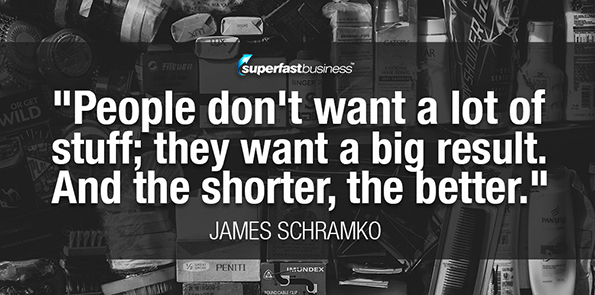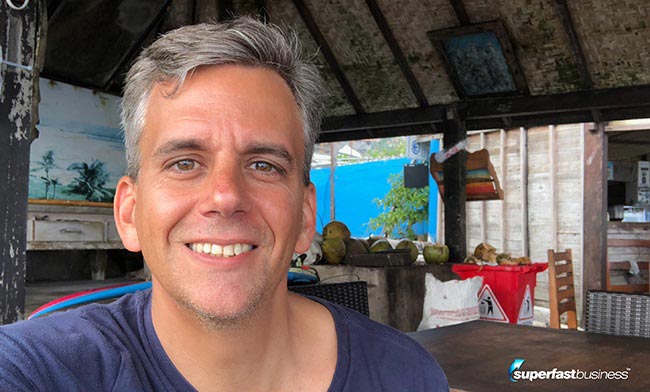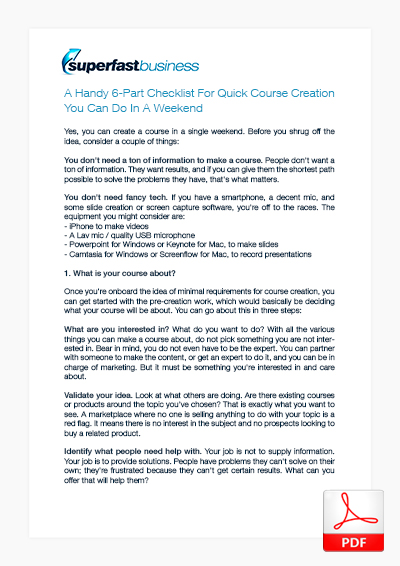Podcast: Download (Duration: 26:42 — 24.6MB)
Get Notified Of Future Episodes Apple Podcasts | Spotify | Amazon Music | Android | Blubrry | Gaana | TuneIn | Deezer | Anghami | RSS | More
Podcast highlights:
00:55 – Has it ever been done?
04:55 – All it takes
06:51 – What’s the hardest part?
08:25 – Two things to look for
09:18 – Is the tech holding you back?
11:45 – The three main steps
13:52 – At the end of this course…
15:10 – You’ve got the outline. Now what?
18:31 – Mapping out – what tools to use
22:20 – If you don’t want to sell…
Produce better, value-laden infoproducts with help from James. We have a training on product creation inside JamesSchramko membership
Transcription
James: James Schramko here. Welcome back to SuperFastBusiness.com. This is Episode 684, How to Create a Course in a Weekend. Welcome to my special guest, John Lint from KLEQ.com.
John: Hey, everybody. Hi, James, how are you?
James: I’m great.
Has it ever been done?
Now, you might see the title of this podcast episode and think, John, I couldn’t possibly create a course in a single weekend. Let’s just get it out of the way. Has it ever been done before?
John: Well, I just did it, actually. So I just created a brand new course, for our KLEQ.com members. And yeah, you know, I filmed on Saturday all the videos; by Sunday, it’s live online, all our members are getting it. So yeah. Now, of course, you know, there’s a big difference between creating those short type of courses that address a specific pain point and solve that specific problem. And, of course, an eight-week masterclass, obviously, you’re not going to create that in a weekend, and it might take a little bit of time. But online courses, the things that when you have the right tools like KLEQ.com, and you know, you and I have been doing this for over 10 years, so, you know, obviously we have practice, but it’s something that you can really do very, very fast. And even if you’re starting out, creating a course is not that difficult. You just need to follow the right framework, the right system, know what you’re going to deliver, have a clear idea of the end result. And then after that, it’s just about following the steps and following the processes, and you’ll get there for sure.
“Even if you’re starting out, creating a course is not that difficult.”
James: I remember having a friend of mine, Steve O, visiting me from Melbourne. And I got a call on a Monday afternoon, it was from an events company. And they said, “James, we have sold a course to some people on how to get started online. And we just discovered the person who was going to be the instructor had actually not as much experience as he’d led us on to believe. He in fact bought a PLR, how to do internet marketing from scratch course, and he was intending to deliver that. And we’re not comfortable about that.”
John: Sure.
James: “Would you take over the training? And we’ll also send you the money that we’ve collected for this course.” And I said, “Yeah, okay. Sure. When does it start?” And they said, “Five o’clock.”
I was like, “Today?” And they said, “Yeah.” So I had just a very short time, I think it was less than one hour to prepare, which I think they’d promised something around an eight-week masterclass. And I said yeah, that won’t be a problem. I sent them a GoToWebinar link, opened up my slide deck, and I drafted the first presentation, which was an outline of what we were going to be covering over the next eight weeks.
John: I love it, I love this.
James: And that was called SuperFast Start. And I recorded each module. Of course, the following week, I had a whole week to do Module Two, and I had a whole week to do Module Three. But of course, when we say a week, what we really mean is a few hours just before the deadline, because that’s when most of our content is created. That was recorded and went on to be a staple sort of training for my membership.
But that’s one case where I remember putting together something in a bit of a rush. These days, I create a new training every single month for SuperFastBusiness members. And sometimes it will take me an hour or two. Sometimes I’ll spend half a day, but very rarely would it take me more than a weekend. I can’t remember ever sitting there over an entire weekend creating that training. So I know it’s possible.
John: Yeah.
James: A couple more examples. Early on, I recognized I needed to create information products. So I actually went out and purchased an audio recorder, a little Dictaphone sort of thing. And I found at an event this guy who had sort of put himself out there as a bit of an expert in Google pay-per-click advertising.
John: Right.
James: And I got him to agree for me to interview him. And I recorded him for an hour, and then I uploaded it online and I created a sales page for it and delivery of the product they purchased. I think it was called SuperFast PPC way back in the day. We’re talking about 12 years ago. But that again, that was a weekend product. And I’ve done many, many courses in a weekend, even my longest, longest course, Traffic Grab. I think there was about 16 hours of content, and I think it took about 30-something hours to create that content. Technically, if you had a late night, and you stayed up a bit and worked hard, that’s still a weekend sort of a course.
All it takes
John: Yeah, exactly. You know, as long as you have a clear idea, and you have a good outline for your online course, meaning, you know, okay, this is what I need to deliver. And remember, you know, when it comes to a course, that’s where people make this mistake where they think, Okay, I’m going to put a ton of information, right? I need to create a ton of information, because surely that’s what people want, right? And in reality, it’s not what they want; they want the shortest path to solving the problems that they have.
“People want the shortest path to solving the problems that they have.”
So that basically gives you the right to not have an insane encyclopedia, but rather focus on short videos or short content that is going to help them move forward and help them go from point A to point B as fast as possible. So you don’t need a ton of content, number one, and that already helps you to create that course in a weekend or as fast as possible.
And yeah, like you said, for our KLEQ.com members, when someone becomes a member, they get access to the entire KLEQ.com Academy, where basically they get a ton of extra bonuses, a ton of courses. And I’m always creating courses because you know, it’s a really easy way for me to package specific information. And whenever I want to create a course about, for example, I just created a course just this one, Your Course in a Weekend for our members to help our members. Last week, on a Tuesday, it took me half a day, and I created a course called Streaming Like a Boss, because Google made some changes to live streaming, so I wanted to address that. This is an entire course showing them exactly how to do everything.
So as long as you have a good outline, and you know what you’re going to do, after that it’s just taking your microphone, talking to the microphone, have a presentation, a Keynote presentation. And that’s it, you’re creating awesome videos, awesome audio. If you want to be on camera, maybe you prefer to be on camera, well, you grab your awesome webcam or your smartphone. Or maybe you want a fancier type of camera, that’s fine. That’s up to you. I don’t do that; I do everything with my smartphone these days, my iPhone, and boom, you know, I record my on-camera videos if I want to do that.
What’s the hardest part?
That’s just process. The hard part is, Okay, what should we talk about, right? What’s going to be that end result? Great, what’s the map? This, this, this. And then after that, it’s just clicking buttons to set up pages. For example, in KLEQ, it’s very easy – click a button, have a new course, title, video, download – it’s just stuff, right? You just do things, and because we remove all the tech stuff, with KLEQ.com, it’s just a matter of clicking a few things and setting things up.
“The hardest part is just talking to the microphone and knowing what to say.”
So the hardest part is just talking to the microphone and knowing what to say. But obviously, if you’re going to be creating a course, you’re an expert. So for you, for me, it’s very easy to talk about our area of expertise, because you know, we’re just talking and sharing our knowledge. So it’s actually very easy. Once you do it once or twice, then you get into the habit, and then it’s just a matter of creating as many courses as you want. So yeah, totally possible. Very easy to do when you know the process.
James: I wanted to create a podcast episode that I could send people to when they tell me, like some of the people who were at a mastermind that I recently visited, they’re talking about, you know, they should be able to get their course together sometime later this year or by next year. And I’m like, what are you talking about? You’re only ever a weekend away, and a log cabin or a motel or, you know, somewhere. It helps occasionally to get out of your normal environment to create content. I actually treat my trips to the Philippines like a creation zone. I’m able to get a lot done when I’m over there in my office there. It’s just, the environment suits. For one thing, it’s a bit harder for me to surf every day, it’s a longer trip to the surf. So I can fill in the time with content creation. But I can create an enormous amount of content when I’m in the right environment.
Two things to look for
So a couple of things to look for. One, if you already have an existing audience, then you probably know what they’re asking for already. And so if you have a membership like I do, or you’ve build your own membership in KLEQ.com, you can always check with your customers or see what they’re asking, and you can create that. And I’ve found it no trouble to make a new course every single month for the last five or six years straight. So you know, I know it’s possible.
“If you already have an existing audience, then you probably know what they’re asking for already.”
Secondly, you don’t need a lot of stuff when you’re making these courses. And I’m talking in two ways here. One is the technology you need to record this stuff. If you have a smartphone, you have enough stuff. If you have PowerPoint, or Keynote, if you’ve got a Mac, it’s actually even built in to record the screen these days. But you could get ScreenFlow for a Mac or Camtasia for Windows, and you are away to the races. You can create a nice little PowerPoint, record it; if you’re shy, you don’t need to be on it.
Is the tech holding you back?
Of course, you can even just record audio, like I did for one of my early information products. And again, that could be done on an iPhone. It could be done on an iPhone with a Lav mic, which will cost you less than $100 at a local electronic shop. You could go, you know, hog wild and buy a microphone of the sort that John or I use, which is going to set you back a few hundred dollars. And these days, they just plug into your computer with a USB. There’s no amplifier required, nothing tricky. You can get a portable recorder; I often take a backup recording on my handy Zoom H4n recorder. It’s also the one I take with me on trips, because it’s, like, indestructible. Even though I’ve somehow managed to destroy the battery cover, it still works fine.
So the technology, I think that stumps a lot of people. But you’re in business with your iPhone as a minimum. You know, you do not need big lights, big DSLR cameras, boom mics and all the stuff. You know, I’ve been there. I’ve had it all. I’ve sold it all. It was very satisfying, actually, when all the little film and arts graduates came around to my house to buy all my equipment that I no longer needed. I had wireless Sennheisers and everything.
John: Yeah, totally.
James: That’s just a distraction.
John: Yeah.
 James: So go low tech, put the minimum amount of things in the course. Remember, they don’t want a lot of stuff; they want a big result. And the shorter, the better. For example, I found a shopping cart abandonment sequence that’s likely to add around 30% more sales. And what I did is I just went and screenshot at what I’m doing, and I put it into a handy training. It took me only a very short time to do that. The longest part of it was actually delivering it live to my audience and then recording it. But now, it’s turned into a PDF as a transcription with screenshots from the presentation. And we strip out the audio. And now when I have a student, and they tell me they don’t have a shopping cart abandonment sequence, I say, Well, I’m very optimistic for you, because I happen to have a training that you can just go and replicate and install into your business, and you should expect a lift in sales. And they do. And they do. And away they go. And so I’ve got lots of little trainings like that.
James: So go low tech, put the minimum amount of things in the course. Remember, they don’t want a lot of stuff; they want a big result. And the shorter, the better. For example, I found a shopping cart abandonment sequence that’s likely to add around 30% more sales. And what I did is I just went and screenshot at what I’m doing, and I put it into a handy training. It took me only a very short time to do that. The longest part of it was actually delivering it live to my audience and then recording it. But now, it’s turned into a PDF as a transcription with screenshots from the presentation. And we strip out the audio. And now when I have a student, and they tell me they don’t have a shopping cart abandonment sequence, I say, Well, I’m very optimistic for you, because I happen to have a training that you can just go and replicate and install into your business, and you should expect a lift in sales. And they do. And they do. And away they go. And so I’ve got lots of little trainings like that.
So we’ve basically discussed the idea that it is possible to create a course in a weekend. If you don’t have an existing audience, but you’re on board with the fact that you don’t need a lot of tech, and you like the idea that you could only do a short course, where do you start?
The three main steps
John: Well, you know, you need to identify in your audience, what is it that they need help with. Right? That’s the first job whenever you enter a market, and you’re thinking about well, what should be the topic of my online course? Well, there’s three steps that I’d like to recommend.
 Obviously, number one is always, everything starts with you, you know? What are you interested in? What do you want to do? Life is too short to do stuff that you’re not going to enjoy. So you can create plenty of courses; don’t create one that you’re not interested about, that you don’t care, right? Just think about all the different things that you could share. Maybe you are not going to be the expert. You can partner with someone, maybe you have a friend, and then he can create the content. Or maybe you can find an expert, and you can maybe give him some money, he can create the content, something like that, but something that you’re going to be interested. Because yeah, there’s the content creation, but then there is the promotion of it. And then there’s the marketing of it, and you need to do some work. So if it’s something that you hate, you’re going to be miserable. We don’t want to be miserable. Us, it’s all about the lifestyle. It’s all about enjoying what you do. So first step is you brainstorm some ideas about the topic.
Obviously, number one is always, everything starts with you, you know? What are you interested in? What do you want to do? Life is too short to do stuff that you’re not going to enjoy. So you can create plenty of courses; don’t create one that you’re not interested about, that you don’t care, right? Just think about all the different things that you could share. Maybe you are not going to be the expert. You can partner with someone, maybe you have a friend, and then he can create the content. Or maybe you can find an expert, and you can maybe give him some money, he can create the content, something like that, but something that you’re going to be interested. Because yeah, there’s the content creation, but then there is the promotion of it. And then there’s the marketing of it, and you need to do some work. So if it’s something that you hate, you’re going to be miserable. We don’t want to be miserable. Us, it’s all about the lifestyle. It’s all about enjoying what you do. So first step is you brainstorm some ideas about the topic.
Number two is to validate. I like to validate my ideas. And how do I do that? Well, I look at, what are others doing? Are others promoting or selling courses about that topic? And the answer that you want is yes. You don’t want to see a marketplace where nobody’s selling that type of topic, you know, that online course about that type of topic or some kind of education product about that topic, because that’s a red flag. It basically means, like, Well, probably you’re not going to make money if you do a course with that topic, right? So I like to validate my ideas, I like to see that other people are selling courses about the same topic I’m thinking about creating. For example, golf – plenty of courses about golfing. Fitness – plenty of courses about fitness, you know, stuff like that, right? So validate is the second step.
And then step number three is to identify, what do we need help with? What do people need help with? Because our job is not, here’s a ton of information, hope you like it, enjoy it. It’s about, okay, they’re having problems with this. They don’t know how to do this. They are frustrated because they are trying to get this result. But if they can’t get it, how can I help them create, with a little product, how can I help them get that result? And that’s what I want to identify.
At the end of this course…
Do those three steps, and you’ve come up with a great topic for your next online course. Right? You will identify what you need to do. Now you have your topic, and after that it’s all about, Okay, well, I know I’m going to talk about this; this is going to be my topic; this is going to be the end result. So a little tip is that, before you create your course, answer this question: “At the end of this course, you will be able to…” When you complete that sentence, it will guide you as you create your course. So at the end of this course, you’ll be able to create an online course in a weekend. That’s my little guideline. And that forces me to focus on that, that way, whatever I do, that is what I need to help them achieve that result. Nothing else matters. I’m not going to include fluff stuff that doesn’t matter if it doesn’t help them get that result.
So by answering that question, by completing that sentence, you will be able to then create the outline. Because then the next question is that okay, well, that’s the end result, how are we going to do it? And by creating the outline, you just reverse engineer the process. Well, they are here, they don’t have a course. I want them to go to point B, where they have a course. What do they need to do? Well, we talked about one already, the first steps – identify your market; identify your topic; creating the outline for the course, that’s step three. And then you have all the other steps that we can talk about in this episode with James. But, you know, that would be the next step, right?
You’ve got the outline. Now what?
And then once you create the outline, it’s just getting to work – start talking into a microphone; start filming; start creating those little videos, those little bits of content. And then once you have them, so that’s actually step number four, create the content, right?
And then step number five, host that content. So you need to host it somewhere online. Many solutions. Amazon S3, which you and I use all the time for all our files – videos, audio – it’s the cheapest solution out there these days. It’s super easy. You have other solutions – Wistia, for videos; Vimeo, for videos; you can use Dropbox for some files, like PDF; you can use Google Drive. Okay? So basically, you host those files online.
And then after that, it’s all about Okay, well, I’m going to create a member’s area that my members can log in, and they can get access to the content. Okay, great. So tons of solutions out there. Of course, with KLEQ.com that you can do everything that you need, such as creating the members area, setting it up, creating the online course right there, making sure that they get their login details. So all of that is integrated, you don’t have to, you know, mess about with plenty of tools.
And then once the course is created, that’s it, it’s done. You have your videos, you have your content. It’s all about maybe setting up a very simple marketing campaign, which again, you can do with KLEQ.com, very simple campaign. The first one that you can get started with any course is simple – sales page, order page, thank you page. Sales page, you can keep it simple. You just talk about what the product is, what it will do for them, what they need to do next, maybe some testimonials, obviously talk about all the benefits. If you want to offer a guarantee, tell them that there’s an X-days money back guarantee, if that’s what you offer. If you want to offer extra bonuses, talk about the bonuses. And then that’s it. Call to action, click on the button to secure your access. When they click, they go to the order page, simple. They enter their details, credit card, or PayPal. And like I said, yeah, all of that it’s built in with KLEQ. You can do all of that – accept payments, order pages, all of that. And then that’s it. They enter their details, they reach the thank you page, they get their login details. That’s it. You have just created your online course, and sold it online. So that would be my checklist. If you’re thinking about creating your online course and you’re starting out, that’s it, you know? Selecting the topic, getting to work, and then it’s just about setting up the different pages.
James: I think one of the vital things there is agreeing what the outcome is before you start. That’s what my mentor used to drum into me. He used to say all the time, what’s the point? Whatever action we were doing, he’d always say, what’s the point? And he wanted to know that we had a clear outcome in mind. And you’re talking about a transformation – at the end of this training, you will be able to do X. That’s the thing they couldn’t do before they started; that’s the result they want. They don’t want to say, by the end of this training, I will be competent at having consumed 100 gigabytes’ worth of information over 58 hours.
John: Exactly.
James: I chuckle whenever I see someone stacking bonuses that are just overwhelming. Even the thought of a big course is scary. So that’s a very, very key point. I love how generous you’ve been in divulging all of those steps. Of course, you’ve put them into a course that we promote together, called OnlineCourseSystem.com.
John: Yeah.
James: And that’s the easiest way to start from scratch. And then by the end of that, you will have your own online course. And you’ll know how to discover what you could be selling, how to put it together, and then marketing the course, all using KLEQ.com, and getting the help of John along the way, as well.
Mapping out – what tools to use
So I have a question for you: when you’re mapping out the course, what sort of tools do you use for that? I’ve heard of people using Post-it notes, sticking them to a mirror or a window. I’ve heard of other people using a paper. Some people like to have electronic versions. Have you found a workflow? Of course, I’ve used a whiteboard a lot in the past, I’ve found that was good as well.
John: Yeah, well, there’s a ton of different techniques, and I tried them all. And the reality is and the most important thing is, it doesn’t matter what you’re using. It doesn’t matter. If you prefer to do whiteboard, then do that. The course I just created in a weekend, this past Saturday, I was doing my groceries in the supermarket; I thought, Hey, I’m waiting for my wife, she’s picking up the veggies. What can I do? I pulled out my iPhone, I opened the Notes app that I have on my iPhone, and I just mapped it out. I said, Okay, well, that’s the end result. What are the things that they should learn that I think are the most important? And I just typed it in. And it’s just a very simple list.
Now you can use mind map software if you prefer; you can use Google notes. You can, like you said, use whiteboard, Post-its. It’s really up to you. But the only thing that matters is that you take action and you get it done. You can even do it on pen and paper, if that’s your thing. I lot of my ideas, I do it on pen and paper, usually in bed, while I’m watching something. All the features that we develop for KLEQ.com, I always start mapping them out on a notepad, on a real notepad, pen and paper. My handwriting is the worst in the world; somehow I’m able to read it again a few days later, it still makes sense.
But you know, just whatever works for you. Because I see a lot of people stopping there – well, what should I use? Which software? I heard these guys are doing this, and this guy has this amazing workflow… It doesn’t matter, okay? Just use whatever you want. And any way, like we said, your course doesn’t have to be 100 videos long. It should be short. So maybe that little piece of paper is going to force you to keep things simple, and to keep things short. That’s what I like to do. I pull out my iPhone, boom, boom, boom, little list. It was done in, you know, obviously, 10, 20 minutes. And then back home, I had this on my screen, and there we go. I just started recording videos one by one about each specific topic, and that’s it.
 So that would be my advice. Don’t get bogged down in tools. That’s not the time to get bogged down in tools. You never want to be bogged down with tools. That’s why we created as well KLEQ.com, so you don’t have to think about that. Let me think about that. You can focus on what matters the most for your business, which is creating content, helping your members and doing your marketing. And the rest, leave it to us, basically.
So that would be my advice. Don’t get bogged down in tools. That’s not the time to get bogged down in tools. You never want to be bogged down with tools. That’s why we created as well KLEQ.com, so you don’t have to think about that. Let me think about that. You can focus on what matters the most for your business, which is creating content, helping your members and doing your marketing. And the rest, leave it to us, basically.
James: That’s right. I imagine, when you’re helping someone go through Online Course System, you’re going to be a very strong bumper baller rail to help them knock down some pins. They’re not going in the gutter with you on the team. I like that. And you know, we as humans, we tend to complicate stuff and procrastinate, because we know if we actually publish this course and start collecting money that’s going to make us uncomfortable. It’ll put us into a new scenario that we’re not used to. So I think there’s a lot of mental resistance to this. Our job on this podcast, Episode Number 684, is to prove you can create a course in a weekend, and you should. Try it. Get out there and do it. You’ve got time, actually, to create four courses before you even have to pay for KLEQ.com if you start it on a trial.
John: Yeah.
James: So put it to the challenge.
John: Exactly. And, you know, one of the things as well, is that you’re absolutely right, James, a lot of people are afraid of what will happen if they succeed with their online course. They start thinking about, Oh, are my friends from work, the work that I’m currently working, are they going to discover my online course? What is my family going to think about when they watch my videos? All of that craziness that goes in our heads.
If you don’t want to sell…
So you know, the recommendation here is that, create the course, fine, just leave it. And if you don’t want to sell it at the beginning, don’t sell it. Use it to build your email list. It’s an amazing way for you to start building your email list if you want to, you know, get people in the door. Fine, give it away for free, but create that course, because it’s one of the most important business assets that you can create. Building your email list is a very important business asset. Creating courses and content that are going to represent your brand – extremely important business asset. Creating your marketing campaigns and have them set up, that way you can reuse them over time – an important business asset. Those are very valuable things.
And you should definitely spend your time during the day, if you’re going to be focusing on valuable things to do in your business, do that. How can I build my list? How can I create awesome content? How can I set up my marketing campaigns? Do that, and that’s what’s going to help you grow your business and really go to the next level.
So if you’re afraid, start by giving away access for free to some people that are going to go through the course. Get testimonials. Extremely valuable, to get testimonials. I’m sure you’re going to get great feedback from those guys who went through the course. And they are going to tell you, hey, this course is amazing. This course is awesome. Thank you so much. That’s going to empower you; you’re going to feel good; your confidence level is going to increase. And now, maybe, you’re not going to be as afraid of saying hey, look at – that a lot of people liked it. Let’s go. It’s just a matter of opening the doors, going to the public, and then you can start selling access to that course.
But it always starts with taking action and getting those videos done. And don’t worry about being on camera. If you don’t like to be on camera, you don’t have to be. Like you said, James, Camtasia on the PC, ScreenFlow on the Mac. Create that content, package your knowledge like that. You can do a bunch of different things. Either give it away for free, or sell it online. But very important for you to create it, because it’s an asset that you can reuse it in multiple, multiple ways.
James: Just thinking, a free course that’s available at the moment on my site’s the free Profit Leverage Course. And I took a keynote that I presented at an event in the Philippines. And the next day, I was sitting on the floor, without air conditioning, with my laptop only, in a room. And I just opened up ScreenFlow, and I recorded me talking over the presentation and then we cut it into three pieces. And we still give that away now. I’m guessing that’s over five years old. And if you listen carefully, you can hear kids playing and dogs barking in the background; it’s by no means perfect in terms of the soundtrack. That presentation went on to inspire my book, Work Less Make More. I don’t know how many thousands of people have gone through that. But it definitely leads people to look at other solutions that I have. And it’s probably due for an update, I’m thinking. But at least I did it back then, even though I wasn’t in the perfect place to do it. I didn’t have the perfect sound. It’s not the ideal, most amazing course. However, it’s out there doing its work versus not having a course at all. So I’ll take that all day long.
John, as always, you are just such a fountain of knowledge. I love these calls, I can just sit back and listen to the knowledge dripping out of the other end of the phone here.
So we have some resources. We’ve got OnlineCourseSystem.com, where you can learn about this from scratch. And you can tear up your excuse lists and finally get a course going with the support of John and the tool and the knowledge. And then of course, if you’re already in motion, or you’ve been struggling with some of the other tools that are out there that get a big marketing hype, but don’t deliver on their promises, then check out KLEQ.com. It’s the platform I’m seeing more students than ever before having success with, even if they’re not technically very capable. And there’s even service providers these days who can design and add things for you. If all you can do is record something and then you have to hand it over from there, there are people who will get you over the finish line these days, because there’s a community around KLEQ.com.
Thanks so much, John Lint. And of course if you like this, keep an eye out for our videos. John and I regularly make videos and we put them on the SuperFastBusiness video channel, and you’ll get lots of tips. And obviously he’s a very smart cookie, and it’s always a pleasure to catch up.
John: Thank you, thank you.
Would you like the entire system for creating a course (includes the tool you need and training)? Go to OnlineCourseSystem.com
Course creation has never been easier – try KLEQ.com today
Liked the show? Leave us a review on iTunes
This site is not part of Facebook or endorsed in any way by Facebook. Facebook is a trademark of Facebook Inc.












Leave a Reply